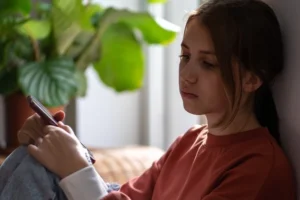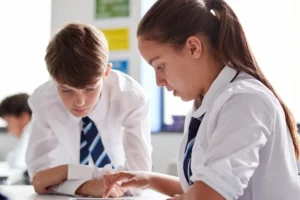Learning about child-on-child abuse
Emma Bradley was unaware of the issue of child-on-child abuse until quite recently. “I don’t think schools are covering this anywhere near enough,” she says. “We might hear more about physical bullying or online bullying, but we’re not really getting to the crux of the issue.” She explains that the landscape has changed a great deal with most kids have access to devices. They are more at risk of receiving inappropriate pictures and clips or “horrible” messages from their peers now than they would have been a decade ago.
When her 12-year-old daughter was targeted on the school bus by other children, Emma began to learn a little more about child-on-child abuse. The other children used the AirDrop feature available on iPhones to force the 12-year-old to watch violent and inappropriate content. Emma’s daughter was “distressed” by the content but took some time to tell her mum about it. And when Emma found out, she wasn’t too sure how to respond at first. “It was a new issue,” explains Emma.
Support from her child’s school
Emma says that her children’s schools run awareness events around anti-bullying week, encouraging random acts of kindness. However, the content doesn’t deal with some of the more harmful, nasty content that children are exposed to. In this way, schools could develop parents’ and children’s understanding of child-on-child abuse to help prevent it.
“When I found out what was happening, we had conversations about it with [my daughter], and I did approach the schools,” Emma says. “Once they knew, the schools were very good about it, and the bus company got involved. Also, the young people themselves were spoken to at school and there were consequences.” She says that the children were spoken to by their heads of year and the other child’s parents were called into the school as well.
What parents and carers can do to prevent child-on-child abuse
The best approach for parents and carers is to help children learn to navigate technology safely. “It’s like learning to drive. We don’t give a 17-year-old a car and tell them, ‘off you go’. We give them lessons and tests. I’m a big believer in teaching children to use technology responsibly.” So, her three tips for parents and carers are:
1. Teach children responsibility of their devices
Emma says that this “might include looking at their messages initially” or setting restrictions on when they can have their phones. For example, they might not be allowed to have their phones in their bedrooms, especially during sleeping hours.
2. Set up privacy and security controls on their devices
“We can tell our children to make sure their AirDrop facility is switched off in public places,” Emma says. Additionally, other privacy and security controls can ensure their safety. For example, knowing how to block and report harmful content or how to ensure the images and content they share is private.
3. Talk about what is and isn’t okay online
“Because [child-on-child abuse] is becoming more commonplace, it’s almost like desensitising us all to it,” Emma says. It’s important to keep having these conversations; just because it’s common, doesn’t mean we should ignore it. “We actually need to show our children that this is not okay and that there will be consequences. . . . Until we’re all involved in telling children that, it’s going to continue.”
Learn more about child-on-child abuse here.





